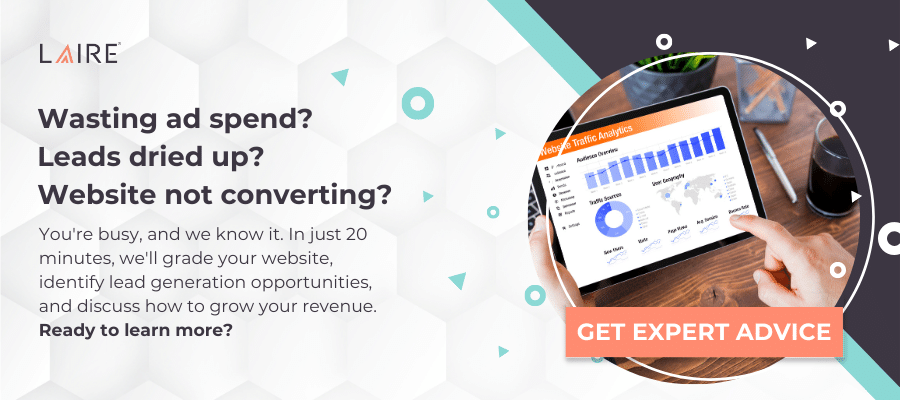Inbound marketing is all about bringing more traffic to your website, turning those visitors into leads, converting leads into customers, and having your customers become advocates for your brand.
A vital part of the inbound marketing methodology is a call to action (CTA), which exists to convert website visitors into leads. But what if the CTA is never clicked on? What if users don't even see the CTA? No click means no conversion.
Whether you aren't getting the results you expect or you're starting from scratch, a brilliant CTA can bring you more leads, clients, and growth.
What Is a Call to Action?
A call to action in marketing is typically a clear and concise statement used to prompt an immediate response from an audience, with the primary goal of driving specific actions or conversions.
CTAs guide users through the customer journey and help you achieve specific objectives, such as lead generation, increasing sales, growing their online presence, or driving user engagement.
To reap the benefits of a CTA, start with a call-to-action statement or button on your website, in an email from your company, in a paid advertisement on a social network or Google, or even in a simple social media post.
Your CTA should lead the user to a landing page where your offer — such as a free consultation or a downloadable resource like an eBook — encourages them to fill out a form and become a lead that you can nurture.
How to Write a Call to Action
It’s clear that CTAs are key to helping you turn website visitors into lasting customers. But how do you entice someone to click your call-to-action button and eventually fill out a form on your landing page?
There are several best practices for writing the best call to action (more on that later), but it really comes down to following our simple formula.
Call to Action Template
Whether you’re offering a simple downloadable checklist or a free quote for your services, calls to action should generally adhere to the easy template below.
When writing call-to-action phrases, answer the following questions:
- Who are you talking to?
- What is their pain point?
- How are you helping them?
- What result are they looking for?
Call-to-action buttons are your true call to action. They’re succinct and engaging and tell the reader exactly what they’re going to receive when they fill out your form.
Keep in mind that we’re not talking about the one-on-one consult or the downloadable workbook they’ll receive here. We’re talking about the overarching benefits coming their way. To identify these benefits, think about how your offer, product, or service saves time, makes life easier, or solves users’ specific pain points.
See our CTA template in the wild with this call to action example from our website:
Call to Action Best Practices
What is a good call to action? Whether you want to encourage sales, generate leads, increase engagement, or promote any other desired action, a well-crafted CTA can make a significant difference. Here are some tips for writing a compelling CTA:
Tailor It to Your Audience
Your CTA should match the interests and needs of your target audience. One way to do this is to ensure that it aligns with the surrounding content on the webpage, email, paid ad, etc. In other words, it should make sense within the overall narrative.
The caveat here is that your content and messaging must be created with your target buyer personas in mind.
Clearly Highlight Benefits
Explain what the audience will gain by taking the desired action. Use straightforward language that leaves no room for confusion; avoid unnecessary words that might dilute the message.
Some of the most well-known examples of a call to action use words like “Download,” “Subscribe,” or “Schedule.” But depending on your industry, these may not be the most engaging verbs to really capture your audience’s attention and entice them to convert.
A little creativity can go a long way in encouraging your readers to set up a free consultation or download an eBook. Here are some out-of-the-box examples of calls-to-action buttons we use on our own website:
- Be a Better Marketer
- Keep My Client List Full
- Turn Likes Into Leads
- Become a HubSpot Superstar
Create a Sense of Urgency
Another way to entice action is by adding in words that relate to time. You can include words like “Today” and “Now” to drive the idea that your offer or resource is important and time-sensitive, adding a sense of urgency.
Make It Visually Stand Out
Without an attention-getting design and the right verbiage, the process of converting a website visitor into a lead can’t even begin. Use contrasting colors, bold fonts, or buttons to make the CTA visually distinct from the surrounding content. And ensure it's easy to spot on the page. After all, if a visitor doesn’t notice your CTA, they’re not going to click it.
If you can, try adding in a glimpse of what you are offering, such as an eBook cover. Your audience will want a sneak peek or preview of the resource they’re signing up for.
Additionally, if your CTA appears on mobile devices, remember that the best call-to-action buttons are mobile-friendly and easy to tap.
Place It Strategically
Position the CTA where it makes the most sense within your content or webpage. It should flow naturally and be easily accessible.
Generally, a homepage CTA should be above the fold (visible without scrolling), while a CTA for a broader-reaching offer might exist in your right-hand sidebar column. Within a product page, content page, or blog that speaks to a specific buyer persona, place a relevant CTA near the bottom of the page as an obvious next step for the reader.
And don’t forget to place calls to action in emails. Emails are a great place to direct traffic to your website and, ultimately, to your form.
Use Social Proof
Incorporate social proof elements, such as testimonials, ratings, or user counts, to boost trust and credibility. Call-to-action examples that use social proof include:
- Join thousands of successful marketers who get our >weekly Marketing Mixtape email with fresh ideas & hot insider tips!
- See why 9 out of 10 experts recommend our solution
- Discover why our product has a 4.9-star rating
- As featured in Forbes, The New York Times, and CNN
Test and Optimize
A/B test your CTAs. A change in one word, a change in placement, or a change in your call-to-action graphic can make all the difference. Make one change, track the change, analyze, adjust, and repeat. But try to never change multiple elements at once, or you won’t know what made the difference for future success.
If you’re using HubSpot, try using the multivariate option for CTAs if you have multiple versions. You will be able to track which version is performing the best and then make further adjustments from there.
Master the Art of CTAs
Building a library of great call-to-action ideas will help you transform web visitors into leads with every piece of new content and marketing campaign you create.
Still, keep in mind that the effectiveness of a CTA can vary depending on your target audience, industry, and specific goals. It's important to continuously monitor and refine your CTAs based on real-world performance data to maximize their impact on your marketing efforts.
Want more tips for supercharging your website’s lead generation power? Our 25 Website Must-Haves Guidebook will help ensure your website is in tip-top shape and working for you — not against you.


